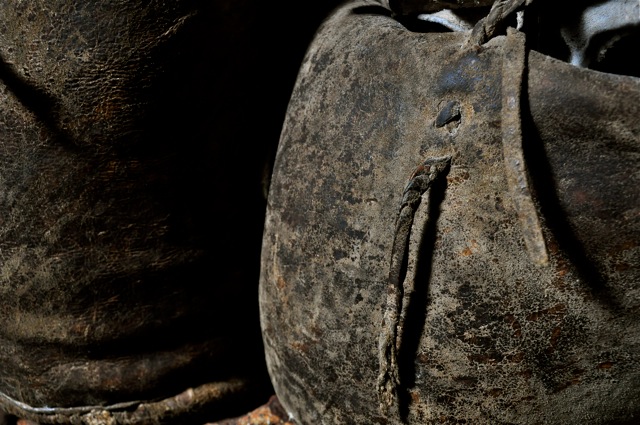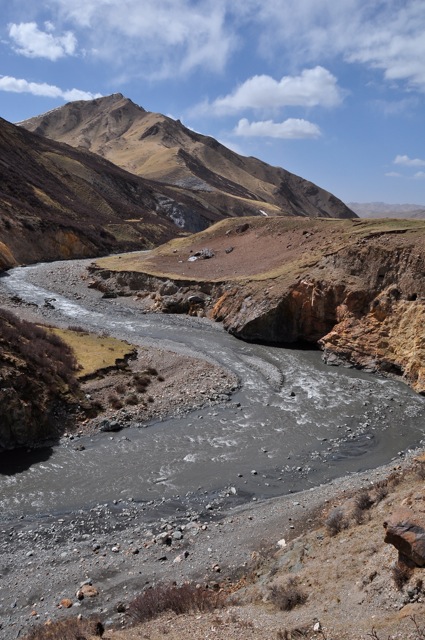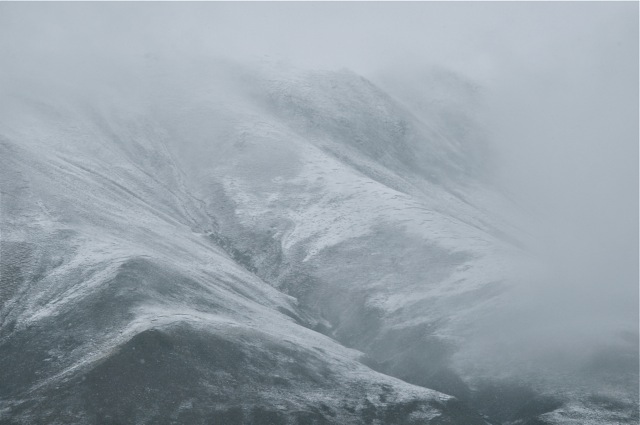Amye Maqen (Amne Machin, Anye Machin) (http://en.wikipedia.org/wiki/Amne_Machin), the stout, the muscular, and for much of time, the utterly hidden from the outside world…our first glimpse of it is of a snow capped wonder that appears far closer than it is. There seem to be as many ways of spelling it as their are potential descriptives. Neither wind blown sand nor a haze can obscure its brilliant bulk. It seems to hang from the sky as we come in from the northwest towards the makeshift town at its base, Xiadawu (or in the more flavoured local Tibetan ‘Da’wurr’ – ‘Place that is difficult for horses’). In Joseph Rock’s accounts of the mountain and bandit ridden regions back in 1930 he estimated the broad peaks of Amne Machin to be 30,000 feet, a guess that was later proven to be 3,000 metres off.
The Amne Machin range itself is an eastern extension of the greater Kunlun Mountain range, one of Asia’s longest most legend laden mountain chains. Located in the Golog Tibetan Autonomous Prefecture it is here that the Yellow River (so named because of wind-blown loess that is carried in from Central Asia) rises before winding eastward. At its rounded and almost friendly white peaks it achieves just over 6,200 metres.
Mountains cannot be compared to other of their kind in my eyes. Mountains are landscapes, heaps of stone and snow unto themselves and each has their own thin-aired identity. Sacred to the Golog (Golok) nomads, Amne Machin is due east of our pristine salt lake near Mado (Mardo) that we’ve most recently left. It also lies on the route that nomads from southwest took to access their precious salt. Few nomadic caravans would pass up the chance to visit and circumambulate the sacred Amne Machin range while undertaking a perilous journey to source salt. Ever practical, the Tibetan traders saw the value of doing both trade for a revered commodity and a little cleansing of past ills.
This mountain that has long played a role in local nomad’s worship of the divine, has withstood weathering seasons and has become more iconic in the eyes of men over time. The fact that it lies as a northwest-southeast diagonal throughway for traders only increases the curiosity for Michael and I. How much is left in memory and physicality of the salt route legacy? How much of any trade route – seldom acknowledged, documented or discussed – will survive? It is in this way that these journeys and explorations are truly ‘exploratory’ with nothing being guaranteed.
The town of Xiadawu, sits in a small cupped valley and is a dusty mess of pool tables, remarkably shabby huts and a main square of errant apathetic dogs that have forgotten their roles. Xiadawu’s decrepit appearance serves as an entry to something far greater than itself, Amne Machin, which erupts to the east. Flowing west out of the mountains past the town, the swerving breadth of the Nam Chu (Nam River) wanders through, over and around valleys in a never-ending search.
Our host, Tsering, is to be found out of town – it is he who will arrange our kora/ circumambulation around the great mountain. The ‘kora’ or clockwise circumambulation literally refers to a pilgrimage. For many eastern religions this act is believed to be a physical way to cleanse or clear away one’s past sins.
If in fact this is the case it may well take a few more than one rotation for Michael and I to wipe our collective slates clean.
Around us the landscape ripples with Spring’s pending arrival – ridges verging on going from ochre to green. Still though, the high peaks remind in a glance that up here at over 4,000 metres winter isn’t really ever truly ‘over’.
Our host Tsering tells us that, yes, the salt traders came through here as part of their annual travels – more specifically nomadic traders, who, coming from further east, would add the kora of the mountain to their travels to the salt lakes. A kind of double-pronged travel plan: salt for need and profit, kora for life-cleansing benefits.
We will not waste much time here in Xiadawu – we crave the wind and the active components of searching and ‘hearing’ about places. It only serves to wet our appetites and to apply this knowledge to actual physical locations. Tangibles rule here in a land of tangibles. Michael and I share this need to keep the bodies in motion, particularly in such landscapes, where in order to partake in a geography one must actually ‘be’ there.
Our intention is to get onto the road and begin tomorrow early in the morning. We will have two yaks as our beasts of burden, one guide on horseback and will travel as light as possible, with mobility being preferred to bulky loads. There is snow still on the ground and we want all bodies to be unburdened. Here in Spring animals are weaker, lighter and not yet fully ready for long-haul travel. The route we will take will be approximately 150 km’s and be the long or ‘outer’ kora route taking anywhere from a week to ten days at four thousand metres or higher. It is early in the ‘season’ and the annual spring migrations of nomads into the mountains’ valleys have not yet begun.
Piling a meal of mutton, rice and cabbage into us at the headman’s home, we shuffle off to bed – me on the floor and Michael and a makeshift elevated mattress. The sky outside is the clear blue-black that mountains host so well, though there is a cold front moving in from the east where the gleaming bulk of Amne Machin lies waiting for us.
A skittish sleep ends with a shattering white light from outside. It is not the brilliant warm beams of sun that crash in through the window but rather a cold clear light that can only be caused by snow. Outside the world is a diagonal bombardment of massive snowflakes driving down into the turf. Our day of departure starts with snow and a few giant cups of tea. The headwoman of the village is already out, wrapped in her wools fearlessly issuing orders.
She flashes a reckless smile at Michael and I as we make our way out into gust and wet flakes. These people know well the importance of a departure…and our pending departure is being coloured by a veil of white.

Women are as tough, if not tougher, than their male counterparts and are equally capable of loading and organizing caravans.











Pingback: Blog posts from Mei Zhang and others about China travel - WildChina
Pictures are stunning. For the seven to ten days that you are trekking, what do you pack for food and how much water must you bring? How do you ensure that you get your proper vitamins and minerals? How wide are the trails and how physically demanding is the trek?
Gen and her grade 10 class
Thanks for the comments and questions – this ‘response’ is for both Gen and Peter. Our food supply is spartan to say the least – this is partly to keep the loads light and partly due to our location – getting fruit, veg and other ‘treats’ is almost impossible given where we are. We have a huge sack of apples, muffins and biscuits….I am often (and now is no exception) am craving cheese as it is my ‘fantasy food’ when in the mountains. Not surprisingly, we are going through a lot of green ‘raw’ Puer tea – we are using mountain streams for our water supplies and in my experiences the high altitude water sources are always good provided water is fully boiled. We haven’t had to use snow to melt as of yet and plot our camp sites according both shelter and available water.
We have an abundance of noodles that we eat two or even three meals a day. One little addition for this trip is a large bag of dulse – like kelp it is loaded with potassium, sodium, iodine and other necessities that we are burning off in heaps. Michael is keeping track of how many calories we are going through daily. It is roughly 2500 + per day and we know for a fact that we aren’t taking in nearly that amount so we must pace ourselves.
We are both taking multi-vitamins and I take heaps of fish oil, morning and night.
As for the physical aspect of the journey we are averaging close to thirty kilometres a day and that is taking us anywhere from 8-12 hours, depending upon how much ascending is being done. The trails in certain areas are no more than wisps, while in other portions we travel in wide valleys kilometres wide. Most fascinating are the portions that have been worn deep into the soil and earth from centuries of pilgrims, traders and migrants…it is here in these areas that we feel the weight and history of the route we travel. The trek isn’t too strenuous. What makes each day potentially different or more difficult is the weather and altitude. Surprisingly it is the intense sun and heat that slows us more so than cold…though the cold saps our strength and drains our reserves. Snow along the path can also slow us down considerably and Michael and I both prefer going up to descending. Descents test the joints and bones more intensely than ascents.
Hope this helps.
Jeff
Great description of some of the logistics and challenges of your adventures Jeff.
Thanks!
Best wishes,
Peter
Like Gen above, I too am curious about the logistics of your expedition, Jeff. Any details that you could provide would be welcome.
Thanks.
Best wishes,
Peter
Pingback: Blog posts from Mei Zhang and others about China travel - WildChina
Hi. Great pictures and interesting text.
We r planning a trip to Amney Manchen in June, wondering how to arrange for the guide and transportation.
if u have any contacts left it would be much appreciated.
Pingback: Amne Machin – A Rush of White and a Kora